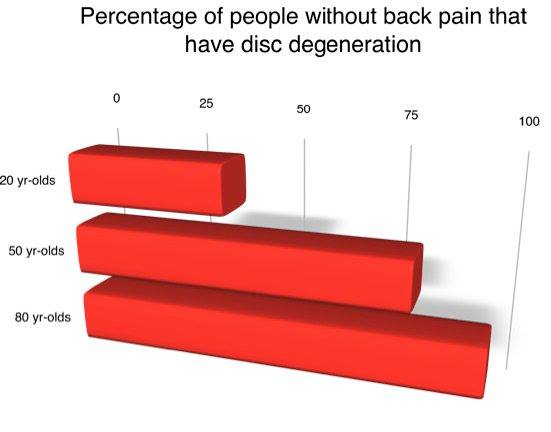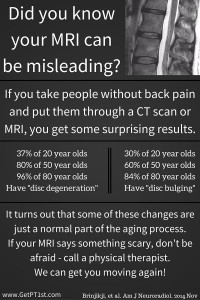Post written by Lucas Krubeck, PTA
I would like to talk for a moment or blog rather about degenerative disc disease (DDD). This is a common diagnosis that we see in the clinic. But what does it really mean? How significant is this finding? And what are you or better yet what are we going to do about it?
First off it’s important to understand the degenerative disc disease, as scary as it may sound, is really just part of the normal aging process. So does it mean that you’ve been diagnosed with a one in a million debilitating disease? No, it means that father time is doing the same thing to the structure of your spine that he’s doing to millions and millions of your other fellow men and women.Disc degeneration is an age-related change – it is like a wrinkle. It does not mean there is something wrong!
The second take home point I want you to get from this blog is recognizing that the good ol’ Triple D is typically not the cause of the discomfort or pain you’re feeling. The MRI or other imaging that shows your degenerative disc disease will continue to show the same findings even after your pain has subsided. If you took 10 people 50 years of age and older off of the streets of your hometown that do not have any back pain, chances are more than half would show signs of (DDD). A recent study showed degenerative changes in all ages of people WITHOUT back pain (Brinjikji et al., 2015).

So what are we going to do about your significantly insignificant finding that you have (DDD)? We are going to use conservative skilled therapy interventions to help you find a balance with your muscle mobility and stability ensure that you have the proverbial tools needed to go through life doing the things you LOVE with safe and effective movement patterns. With or without imaging to confirm the presence of degenerative disc disease our treatment plan for you will be the same; we need to get you moving and assess and treat any strength, endurance, balance and mobility deficits that may be holding you back and causing your current symptoms.

You owe it to yourself to exhaust all your efforts with conservative physical therapy before committing to a spinal fusion or other surgical interventions. Now of course there are times that the Triple D is a contributing factor but don’t give it more credit than it deserves!
References
Brinjikji, W., Luetmer, P. H., Comstock, B., Bresnahan, B. W., Chen, L. E., Deyo, R. A., … Jarvik, J. G. (2015). Systematic literature review of imaging features of spinal degeneration in asymptomatic populations. American Journal of Neuroradiology. http://doi.org/10.3174/ajnr.A4173